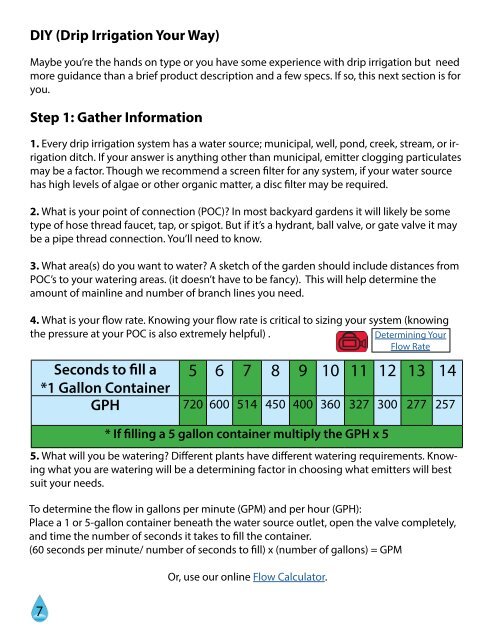Improved!
1I6Q5lJ
1I6Q5lJ
Create successful ePaper yourself
Turn your PDF publications into a flip-book with our unique Google optimized e-Paper software.
DIY (Drip Irrigation Your Way)<br />
Maybe you’re the hands on type or you have some experience with drip irrigation but need<br />
more guidance than a brief product description and a few specs. If so, this next section is for<br />
you.<br />
Step 1: Gather Information<br />
1. Every drip irrigation system has a water source; municipal, well, pond, creek, stream, or irrigation<br />
ditch. If your answer is anything other than municipal, emitter clogging particulates<br />
may be a factor. Though we recommend a screen filter for any system, if your water source<br />
has high levels of algae or other organic matter, a disc filter may be required.<br />
2. What is your point of connection (POC)? In most backyard gardens it will likely be some<br />
type of hose thread faucet, tap, or spigot. But if it’s a hydrant, ball valve, or gate valve it may<br />
be a pipe thread connection. You’ll need to know.<br />
3. What area(s) do you want to water? A sketch of the garden should include distances from<br />
POC’s to your watering areas. (it doesn’t have to be fancy). This will help determine the<br />
amount of mainline and number of branch lines you need.<br />
4. What is your flow rate. Knowing your flow rate is critical to sizing your system (knowing<br />
the pressure at your POC is also extremely helpful) .<br />
Determining Your<br />
Flow Rate<br />
Seconds to fill a<br />
*1 Gallon Container<br />
5 6 7 8 9 10 11 12 13 14<br />
GPH 720 600 514 450 400 360 327 300 277 257<br />
* If filling a 5 gallon container multiply the GPH x 5<br />
5. What will you be watering? Different plants have different watering requirements. Knowing<br />
what you are watering will be a determining factor in choosing what emitters will best<br />
suit your needs.<br />
To determine the flow in gallons per minute (GPM) and per hour (GPH):<br />
Place a 1 or 5-gallon container beneath the water source outlet, open the valve completely,<br />
and time the number of seconds it takes to fill the container.<br />
(60 seconds per minute/ number of seconds to fill) x (number of gallons) = GPM<br />
Or, use our online Flow Calculator.<br />
7


